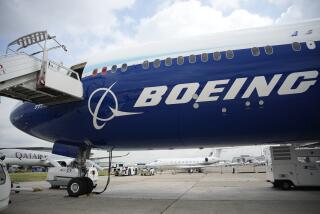Worsham Will Retire as President of Douglas Aircraft
- Share via
Douglas Aircraft President James E. Worsham, the hard-driving airplane salesman who is widely credited with the historic turnaround of McDonnell Douglas’ commercial aircraft business in the 1980s, will step down May 1.
McDonnell Douglas named Robert H. Hood Jr. to succeed Worsham, who will turn 65 in April and leave under the company’s mandatory retirement policy. Worsham said in an interview Friday that he is considering a new job at McDonnell after he leaves Douglas, but declined to say what he might do.
“I clearly do not want to retire,” Worsham said. “I am blessed with excellent health and lots of energy. Another year (at Douglas) would have been great.”
Douglas teetered on the brink of closure in the 1982 when Worsham arrived from General Electric. Its sales were stalled and it was financially bleeding from efforts to develop several expensive new aircraft.
Seven years later, Worsham leaves Douglas with a military and commercial aircraft backlog at record levels and its operations solidly profitable.
Leaving as a Winner
Douglas delivered 133 aircraft in 1988, took funded orders for 260 new aircraft and signed up options for 295 additional aircraft. Including orders and options, the company has potential future business in hand of more than $40 billion.
“It was a heck of a good year,” Worsham, a native of Kentucky, said in his understated Southern drawl. “It’s good to leave a winner.”
Worsham’s own enthusiasm generates excitement about airplanes, and it is Douglas airplanes that give him his greatest sense of satisfaction, he said.
“Douglas airplanes are safe and reliable,” said Worsham, a mechanical engineer. “They are structurally sound.”
Boeing is now facing increasing scrutiny of the structural integrity of its older aircraft.
“We design ours to last a little longer,” Worsham said. “We make them a little heavier. We go all out in corrosion resistance. We think that’s the way to go. DC-3s, we think, will go forever. That’s as far as I want to go. I don’t want to throw any rocks at my competition.”
Hood is not well known at Douglas. In his current assignment, he is president of McDonnell Douglas Missile Systems Co., but has served there for only several months.
Hood, 56, joined McDonnell in 1965 as a government sales representative in Washington. He later served as a bureaucrat at the space agency and then as an executive at Pullman Inc. He returned to McDonnell in 1982 as vice president at the first Astronautics unit. A former Air Force pilot, he has bachelor’s degrees in engineering and business from the University of Pittsburgh.
Hood’s short tenure in his most recent job at a newly formed unit of McDonnell Douglas led some company managers to question Friday whether executives in St. Louis had recently altered their succession plans.
Despite an unusually terse public announcement that Worsham would be stepping down as Douglas president, McDonnell Douglas Chairman John F. McDonnell praised Worsham to the staff.
“Since 1982, Jim Worsham has been uniquely responsible for Douglas Aircraft Corp.’s tremendous turnaround,” he said in a management bulletin. “From near extinction in 1983, Douglas has grown in sales from $1.9 billion to $4.9 billion in 1988 and from a loss of $52 million to a profit of $127 million.”
Big Jump in Profit
Separately, the company reported Friday a large jump in profit that caught securities analysts by surprise. It earned $350 million on sales of $15.1 billion in 1988, compared to earnings of $313 million on sales of $13.7 billion in 1987.
The company said earnings increased in all of its business segments, except for information systems, which lost more money than the year before. A sharp jump in profit at the company’s military aircraft unit in St. Louis was primarily responsible for the increased profit.
At the Douglas unit, pretax profit increased to $127 million from $108 million in 1987. But Douglas recorded $21 million in gains on aircraft lease conversions and lease sales in 1988, compared to $78 million in 1987.
Aircraft sales at Douglas soared to $4.88 billion in 1988 from $3.97 billion in 1987.
More to Read
Inside the business of entertainment
The Wide Shot brings you news, analysis and insights on everything from streaming wars to production — and what it all means for the future.
You may occasionally receive promotional content from the Los Angeles Times.










